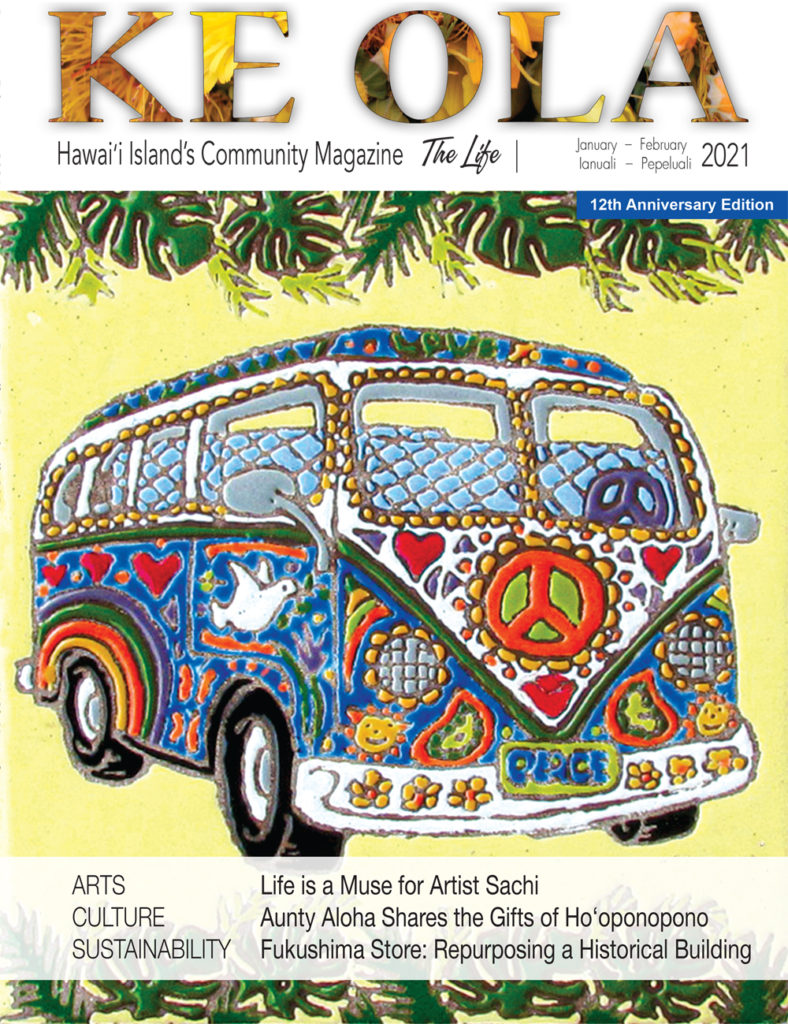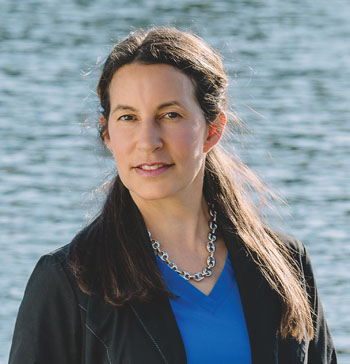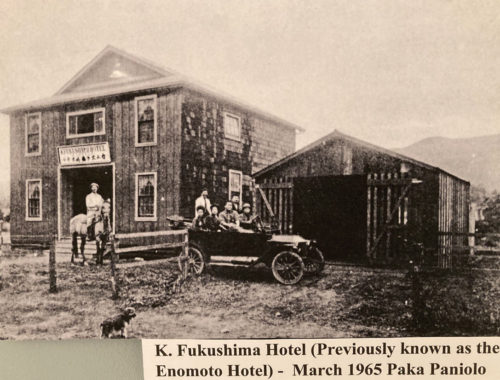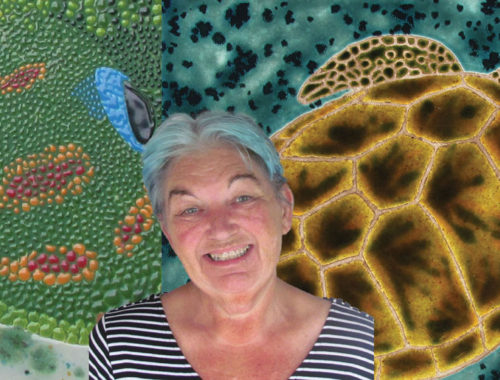
Talking Hula with Kumu Aloha Victor

By Karen Valentine
The conversation begins with a hug, even in the time of COVID-19. This serious kumu hula (hula teacher) tests himself regularly, not only for the health of himself and his students, but in life itself. After entering his hālau (group) hula space, where he teaches all ages, Kumu Aloha Victor (born Kenneth Dean Alohapumehanaokala Victor) invites me to sit on the floor for our interview. Yes, this is hula. I am somewhat surprised, but my hula training has prepared me for this!
For a relatively young kumu, age 42, the number of trophies amassed in competitions by this hālau is impressive. Kumu Aloha could only have done this through a solid grounding in the traditions of hula, an intense drive, plus a love of his students, focused on shaping their lives in a positive way.
Early Influences
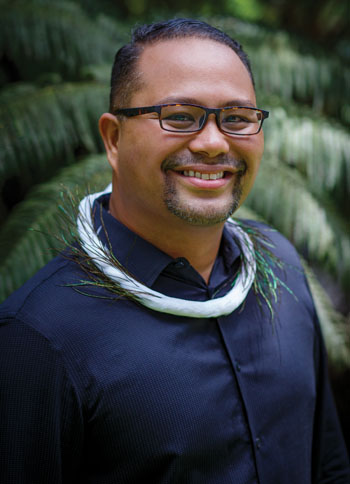
Young Aloha grew up in rural South Kona, in coffee growing and ranch country. “My great-grandfather, Frank Silva, is the last surviving original cowboy of Greenwell Ranch. We ran amuck,” he says, “and walked to Hōnaunau Elementary School from our coffee farm.”
Did he dance hula then? “We didn’t have a choice.” Hula came after catechism at St. Benedict’s Church and was taught by Aunty Hualani Brandt (Aunty Landy), who then gave them rides home.
After his family moved to Kailua-Kona, the next kumu who influenced his dance was the renowned Uncle George Naope, one of the founders of the Merrie Monarch Festival. Aloha took classes during the summer through his sophomore year in high school, when Uncle George wasn’t traveling to teach in Japan. “I can still do backbends and duck walks, because he made us do it so much. We practiced in his cement garage in Royal Poinciana subdivision. That’s why we all have ugly knees! No matter how much it hurt, you make it look easy and make it look great,” Aloha remembers.
After that kind of tough love, he says, “Now, I make sure my students have a clean environment and everything we never had. We might say they’re more entitled and privileged.” That’s not to say his students aren’t put through rigorous training, especially when preparing for competition.
Kumu Aloha also accumulated plenty of onstage experience as a lū‘au show dancer with the late Kumu Hula Keoni Atkinson at Kona Village Resort and in the men’s hālau and lū‘au shows with Kumu Nani Lim Yap, of the well-known Kohala music and hula family. Within several years of performing shows, he also learned “everything and anything backstage”—make-up, hair, lei, and costuming.
Top that off with in-depth Hawaiian cultural studies at the University of Hawai‘i at Hilo including training with Taupōuri Tangarō, husband of Kekuhi Kanahele, granddaughter of the iconic Kumu Hula Edith Kanaka‘ole. This higher learning of hula, which he calls “elemental and engaging,” made a huge impact on him. Tangarō would later confer Victor with his ‘uniki, hula’s formal graduation.
Hālau Kala‘akeakauikawēkiu

In 2005, Aloha decided it was time to start his own hālau. “I called Aunty Landy’s daughter to respectfully ask permission. She told me, ‘My mom always said it was going to be you. Not me, but you.’”
The hālau’s name, Hālau Kala‘akeakauikawēkiu, came to him while picking ‘ōhelo berries on Hualālai mountain. “I looked up as the sun was shining through on the mountain. The name means ‘the light at the highest summits.’ It was several months before my son was born and it also became my son’s middle name. That name represents strength and always trying to get higher to reach our goals. That light is the guide for us to reach all that we can. I don’t care about all of those trophies; it’s your personal growth, how you’ve achieved your own greatness through your efforts.”
In 2006, at age 28, Kumu Aloha had his full hālau established and in 2007 had already jumped into competition. “And we were winning,” he said, with people asking, “Who’s the new kid on the block?”
Hula is about more than learning the dance. “I don’t only teach choreography. I teach you how to stand, how to walk; I teach you how to research and how to present that research, because you are going to present it to your classmates. To build camaraderie and also have fun, we do sleepovers, tea parties, and beach games. I believe in learning while not losing your childhood. I incorporate this into normal hula activities. We practice and then have dinner at the ocean, with the parents bringing dinner.”
At this time there are about 73 students in five different classes: keiki from five to 12 who prepare for keiki competitions, Merrie Monarch competition class beginning at age 14, two different adult wahine (women) classes, and kupuna class. Kumu Aloha teaches all of the classes and has coordinators to handle arrangements, fundraising, and bookkeeping.
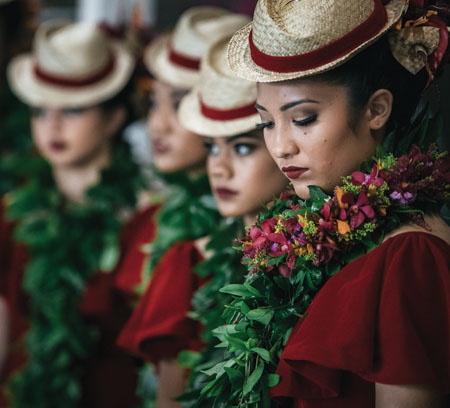
He shares, “We have changed lives and impacted people’s lives with hula. We have taught hula passed down through generations. I believe in leadership. Through hula and teaching them the little things, we start to build little leaders. Even when they’re five or six years old, they learn to lead the newer ones.
“If it’s competition season, we start prepping early. People don’t realize that those seven minutes on Merrie Monarch stage represent thousands of hours of preparation.
“I can fix choreography but I can’t force camaraderie. You have to love each other. People who don’t dance hula don’t understand it is a very disciplined art; it’s not easy. It’s our job to make it look easy.
“The best part of hula is that we change, we evolve, and open communication is the biggest, most important factor. Hula families who have danced with us sometimes say, ‘We don’t know what we would have done if there hadn’t been hula for us.’”
Honoring the Past to Secure the Future
Kumu Aloha is strict about keeping the original intent of each traditional dance and song that has been passed down over generations. He does intensive research before competitions to learn as much as possible about the dance, the music, and the origin of the mana‘o (wisdom) for the presentation.
“I was honored to be one of four kumu who took workshops with Aunty Pat Bacon, daughter of Mary Kawena Pukui, to share things she learned from her mother during the 50s and 60s—to keep hula alive. We watched old videos and danced while she would correct us. I use that teaching with the kids ʻtil today. Keeping the traditions, whatever the style that comes with those songs, we keep it. We are not allowed to change anything from Pat Bacon’s teaching.”
When preparing for their 2017 Merrie Monarch hō‘ike (open to the public show) and then their first Merrie Monarch competition in 2019, Kumu Aloha had picked, as the theme, 19 original songs from Kona.
“It was actually very hard to find Kona songs written by Kona people. We researched families and worked with Kona Historical Society and Bishop Museum, and studied old newspapers. For a lot of the songs, the correct melodies have been lost. We asked our musicians to ask older musicians how they remembered them. Then we presented the songs to the families and told them we were going to do it like their great grandfather sang it. Many times, they didn’t know. Everybody had a fabulous binder after the competition.”

Service to Community
Kumu Aloha is passionate about his haumana (students) doing community service. They schedule four trips per year into the forest where all serious hula hālau go to gather greenery for their hula pa‘u skirts, lei, adornments, and altar. “We go to the forest to gather before competition, and after competitions to clean up for those who don’t know to do that.” They have adopted an 11-acre parcel at Kalōpā near Honoka‘a where they focus on reforestation. “The forests have changed over the years. We go to the same place and use a quadrant method dividing the parcel into four sections. We always pick from one quadrant, and the next time in another one. We fertilize, water, clean, and weed. Students and parents have to understand that if we don’t do this, who will? We challenge the other hālau to do the same.”
The participants select specific plants that are traditional to hula, for example, palapalai fern. “We’re dancing for Laka [goddess of hula]. We need to use kinolau [embodiment] for Laka.” When people join hālau he recommends they plant 100 ti plants on their own land. “We ourselves are going to become the lei shops.”
Clothing Line
To earn money while in school, Aloha worked at a fabric store and learned to sew. The idea came to him while sewing for his daughter to create a keiki clothing line. More ideas came with clothing his hālau, and not only for competition. “With hālau, we have to buy a lot of fabric and do a lot of costuming, designing also the outfits we wear after competitions. People started asking if we had them for sale.” Beginning small, selling just a few items, then responding to more demand at the Merrie Monarch craft fair, an official clothing line was born: Kaulua‘e. The name follows the same pattern as his philosophy.
“It means to grow upward, such as the maile plant that reaches toward the sun, and always absorbing what you
learn.” ❖
All photos by Dina Morrow Photography, courtesy of Halau Kala‘akeakauikawēkiu
For more information:
ktownhula.com
kauluaehawaii.com
